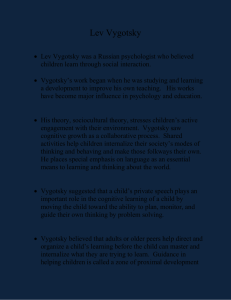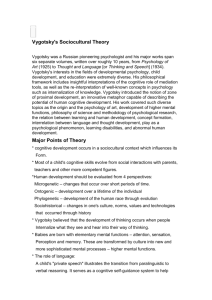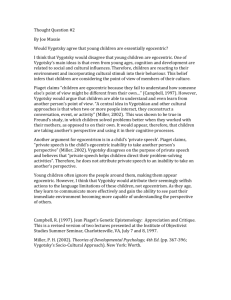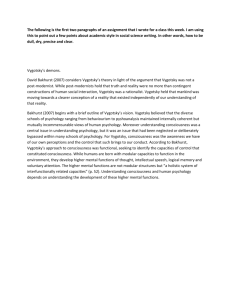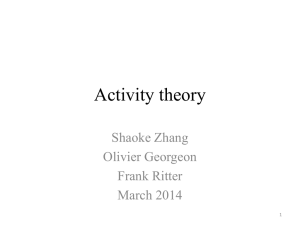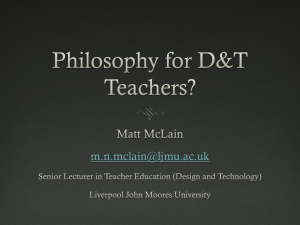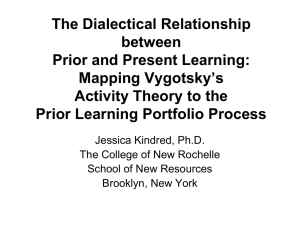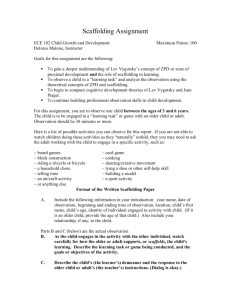Vygotskian Theory. - The Gevirtz School (GGSE)
advertisement
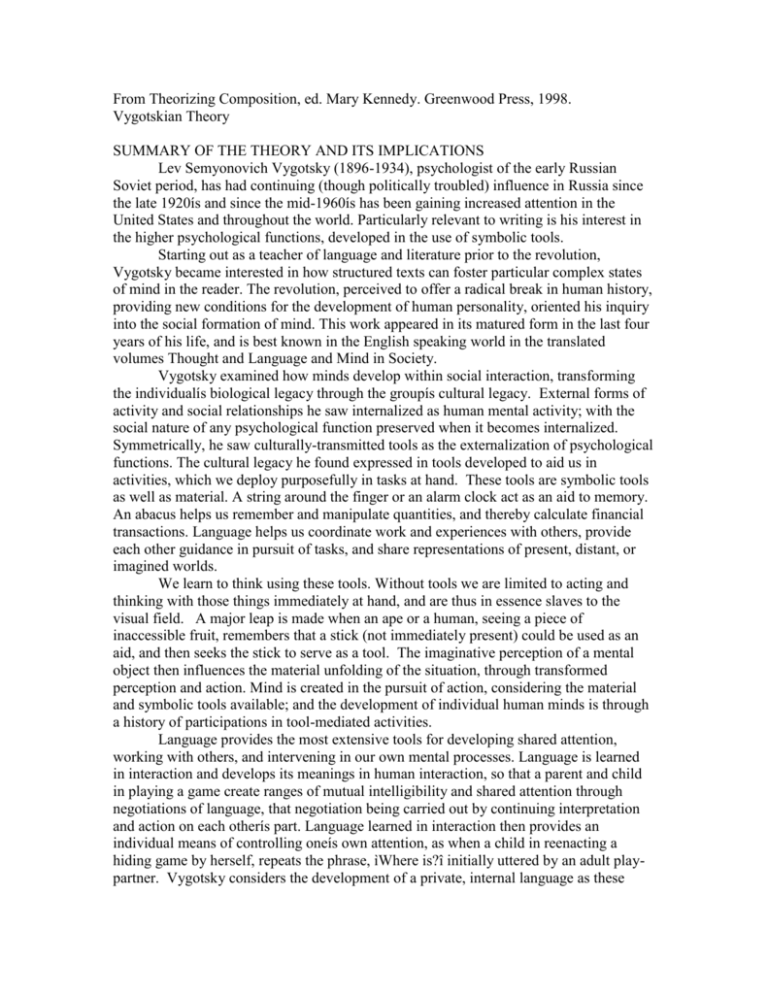
From Theorizing Composition, ed. Mary Kennedy. Greenwood Press, 1998. Vygotskian Theory SUMMARY OF THE THEORY AND ITS IMPLICATIONS Lev Semyonovich Vygotsky (1896-1934), psychologist of the early Russian Soviet period, has had continuing (though politically troubled) influence in Russia since the late 1920ís and since the mid-1960ís has been gaining increased attention in the United States and throughout the world. Particularly relevant to writing is his interest in the higher psychological functions, developed in the use of symbolic tools. Starting out as a teacher of language and literature prior to the revolution, Vygotsky became interested in how structured texts can foster particular complex states of mind in the reader. The revolution, perceived to offer a radical break in human history, providing new conditions for the development of human personality, oriented his inquiry into the social formation of mind. This work appeared in its matured form in the last four years of his life, and is best known in the English speaking world in the translated volumes Thought and Language and Mind in Society. Vygotsky examined how minds develop within social interaction, transforming the individualís biological legacy through the groupís cultural legacy. External forms of activity and social relationships he saw internalized as human mental activity; with the social nature of any psychological function preserved when it becomes internalized. Symmetrically, he saw culturally-transmitted tools as the externalization of psychological functions. The cultural legacy he found expressed in tools developed to aid us in activities, which we deploy purposefully in tasks at hand. These tools are symbolic tools as well as material. A string around the finger or an alarm clock act as an aid to memory. An abacus helps us remember and manipulate quantities, and thereby calculate financial transactions. Language helps us coordinate work and experiences with others, provide each other guidance in pursuit of tasks, and share representations of present, distant, or imagined worlds. We learn to think using these tools. Without tools we are limited to acting and thinking with those things immediately at hand, and are thus in essence slaves to the visual field. A major leap is made when an ape or a human, seeing a piece of inaccessible fruit, remembers that a stick (not immediately present) could be used as an aid, and then seeks the stick to serve as a tool. The imaginative perception of a mental object then influences the material unfolding of the situation, through transformed perception and action. Mind is created in the pursuit of action, considering the material and symbolic tools available; and the development of individual human minds is through a history of participations in tool-mediated activities. Language provides the most extensive tools for developing shared attention, working with others, and intervening in our own mental processes. Language is learned in interaction and develops its meanings in human interaction, so that a parent and child in playing a game create ranges of mutual intelligibility and shared attention through negotiations of language, that negotiation being carried out by continuing interpretation and action on each otherís part. Language learned in interaction then provides an individual means of controlling oneís own attention, as when a child in reenacting a hiding game by herself, repeats the phrase, ìWhere is?î initially uttered by an adult playpartner. Vygotsky considers the development of a private, internal language as these traces of social language remain only in fragmentary internalized form, directing attention and cognition. What appears on the intramental plane of the individual first appears on the intermental plane of social interaction. As one learns, in practical apprenticeship, to use the cultural-historical legacy of the carpenterís toolkit within the circumstances and tasks where the tools are demonstrated to be useful, so one learns to use, in daily interaction, the cultural-historical legacy of the language toolkit one is introduced to as a social medium; one then learns, through internalization, to use the language toolkit as the individualized medium of cognition. What an individual may then be able to accomplish by oneself contains the residue of many previous interactions in the form of memories and tools, as well as the cultural memory built into the tools. What that person can do in new circumstances is further expanded by coordination with a partner who brings a different set of tools and memories to that task. The extent of coordination is as well affected by the tools of coordination--that is how flexibly and well one can talk and work with the partner. This new coordination allows one to reach beyond oneself in doing new tasks, learning new skills, imagining new thoughts. This area of interaction Vygotsky calls the Zone of Proximal Development. Oneís ability as a learner, for example is not to be measured simply by what one already knows, but by the extensiveness of the new situations one is able to enter into successfully and thus learn from. Similarly, to make learning available for students, instructors must bring new material and skills into a zone of intelligibility, possible participation, and motivated interaction. Students recognize and incorporate the new tools only insofar as they help direct and shape attention and motives already forming in pursuit of some desired object. Vygotsky originally conceived the Zone of Proximal Development in terms of the dyad of a learner and an adult or more skilled peer, such that the zone was defined entirely by the larger knowledge and competence of a dominant matured person. We can, however, also think of a more open space of responsiveness as any two individuals of different skills, knowledge, and perception meet over a shared task, provide communicative challenges to each other, or together explore new tasks and situations. That is, learning through interaction can occur in a variety of circumstances that are not pre-determined by finite known skills embodied in a teacher. Language in its abstract representations radically extends the reach of our imaginations, and allows others to bring to our mind non-present objects, not only from our shared prior memories (ìthe lunch we had last Tuesdayî), but from the experience of one but not the other (ìthe fabulous restaurant I went to last week that I must tell you aboutî), or even reported events that neither shared (ìthe recipes Yasmin told me about which she had learned from her familyî). Vygotsky was particularly interested in how the cultural heritage of organized concepts transmitted in school (usually translated unfortunately as ìscientific conceptsî) transformed the mind and thought of adolescents. Within his particular historical moment, Vygotsky did not, however, relativize or otherwise problematize official learning as embodied in school subjects nor did he doubt univocal progress in science; rather he saw the immediate challenge as educating an unschooled and poor peasantry. Nor did Vygotsky consider the other organized discourses that shape the character of interaction and cognition within other social institutions, such as scriptural religions, law, medicine, or commerce, such culturally organized discourses with their particular sets of discursive tools equally provide sites for individual development and transformation. Further, communal knowledge and memory are potentially expandable to all things reportable within the socio-linguistic communication systems we have developed; however, this knowledge is only transmitted through the differentiated social groupings, situations, and socio-linguistic media by which we encounter the utterances of others. That is, the linguistic resources and sites for social interaction may be fractured and multiple. Vygotsky, in discussing the development of childrenís ability to use literate signs, considers how written language might differ from spoken language as a tool along with writingís consequences for human cognition. He points out that alphabetic writing is a second order sign, or a sign of a sign. A picture can directly suggest an object, event, situation or memory. A word can directly call to mind the referrent of the word. A spelled, alphabetic word, however, only represents the sounds of the spoken word. Writing is also further removed from the interlocutor than is speech. The abstraction of written language from experience presents special challenges for learning and motivation. Furthermore, the distance writing creates between experience and representation and between utterer and audience encourages reflection upon and fascination with written signs as a system in themselves, both for good and ill. VALUE OF THEORY FOR WRITING AND TEACHING OF WRITING Vygotsky thus presents an account of mental growth in relation to language learning and participation. He points to the use of written language as a tool that extends our mental reach and provides opportunities for more extensive interactions. Texts provide resources that can potentially extend the zone of proximal development if students are brought into interaction with those texts in pursuit of their own objects-whether to build a model airplane or to articulate an understanding of oneself and oneís world, or to argue to change an obnoxious policy. The act of writing then can be seen as speaking to rich interactive environments drawing on the discursive resources provided by the environment, both as previously internalized by the writer and as newly sought and brought to bear on the occasion. For writing teachers, Vygotsky draws our attention to the importance of constructing social and problem environments that will draw students into tasks that will extend their language competences. We need to attend both to the motives that impell our students and the situations and resources we establish in the classroom that will provide the tools and opportunities for student growth. Further Vygotsky points us toward the use of language for monitoring and selfregulating our behavior, so that meta-languages of writing instruction, whether rules, instructions, guidelines, rhetorical concepts, or other reflective vocabulary can assist choice-making in writing. However, such meta-languages are useful only when they coordinate with the students own motives and perceptions, so that they become internalized into studentsí minds and thoughts in orienting to writing situations. That is, the meta-languages of language of instruction only provide positive educational value when brought into a zone of proximal development formed around motivated student writing tasks. RECEPTION AND SIGNIFICANCE IN EDUCATION AND COMPOSITION STUDIES The richness and depth of Vygotskyís thoughts have inspired a great variety of work, and lies behind such now familiar and widely used concepts as situated cognition, distributed cognition, guided participation, scaffolding, cognitive apprenticeship, legitimate peripheral participation, and communities of practice. The ideas of Vygotsky and his followers have been increasingly influential in education studies (see Dyson, Moll, and Smagorinsky), and related ideas have been elaborated under the rubric Activity Theory (see entry in this volume). Among compositionists who have drawn directly on the work of Vygotsky are Bazerman, Berkenkotter and Huckin, Dias et al, Nystrand, Prior, and Zebroski. Within composition studies, Vygotskyís ideas are often linked to the dialogism of Mikhail Bakhtin (see entry in this volume), but they also stand behind much of the work in genre theory and the study of specialized discourses (see entry in this volume). Of great importance in understanding the psychology of literacy is the work of Scribner and Cole. BIBLIOGRAPHY Primary Texts Vygotsky, Lev S. Thought and Language. Cambridge, MA: MIT Press, 1986. Vygotsky, Lev S. Mind in Society. Cambridge, MA: Harvard University Press, 1978. Vygotsky, Lev S. Psychology of Art. Cambridge, MA: MIT Press, 1971. Vygotsky, Lev S. Collected Works. Vol 2. The Fundamentals of Defectology. New York: Plenum Press, 1993. Vygotsky, Lev S. & A. R. Luria. Studies on the History of Behavior: Ape Primitve, and Child. Hillsdale, NJ: Erlbaum, 1993. Selected Secondary Texts Kozulin, Alex. Vygotskyís Psychology. Cambridge, MA: Harvard University Press, 1990. van der Veer, Rene & Jan Valsiner. Understanding Vygotsky. Oxford: Blackwell, 1991. Wertsch, James, ed. Culture, Communication, and Cognition: Vygotskian Perspectives. Cambridge: Cambridge University Press, 1985. Selected Scholarship in Education and Composition Bazerman, Charles. Shaping Written Knowledge. Madison: University of Wisconsin Press, 1988. Bazerman Charles. Constructing Experience. Carbondale: Southern Illinois University Press, 1994. Berkenkotter, Carol & Tom Huckin. Genre Knowledge. Mahwah, NJ: Erlbaum, 1994. Dias, Patrick, Aviva Freedman, Peter Medway, & Anthony ParÈ. Writing in Academic and Workplace Contexts. Mahwah, NJ: Erlbaum, 1998. Dyson, Anne H. Social Worlds of Children Learning to Write in an Urban Primary School. New York: Teachers College Press, 1993. Moll, Luis C., ed. Vygotsky and Education. New York: Cambridge University Press, 1990. Nystrand, Martin. The Structure of Written Communication. Orlando, Fla.: Academic Press, 1986. Prior, Paul. Writing/Disciplinarity. Mahwah, NJ: Erlbaum, 1998. Scribner, Sylvia & Michael Cole. The Psychology of Literacy. Cambridge, MA: Harvard University Press, 1981. Smagorinsky, Peter. ìPersonal Growth in Social Context.î Written Communication 14:1 (1997): 63-105. Zebroski, James. Thinking Through Theory. Portsmouth, NH: Boynton Cook, 1994. Charles Bazerman University of California, Santa Barbara
